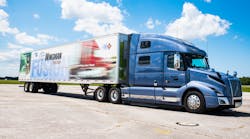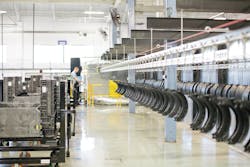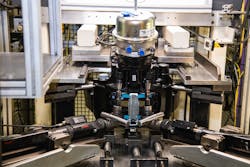Preparing for the next generation of safety technology and advanced driver systems
Business has been anything but usual over the last 11 months, as the world has reacted and adapted to changes in the wake of COVID-19. The global commercial vehicle industry is no exception, but with the adjustment to new processes and revised expectations, companies like Bendix, and it’s parent company, Knorr-Bremse, have also continued to assess and prepare for the future.
FleetOwner spoke with key executives Dr. Peter Laier, Knorr-Bremse executive board member, and Mike Hawthorne, Bendix president and CEO, to discuss how business expectations have changed since early 2020, as well as the progress of vehicle technology development to address fleet needs today and in the future.
Laier and Hawthorne discussed business performance at the onset and in the wake of the pandemic, updates to the organization’s structure, current industry trends, and future technology opportunities.
Shifting business expectations
Coming off of record orders in 2018, the commercial truck industry overall expected a slowdown in 2020.
“2020 was expected in most markets to be a kind of a replacement year after a decade with really good demands in most of the global markets. The first quarter confirmed basically in most markets this assumption,” Laier said. “Then, a pandemic hit us.”While the second quarter saw an abrupt drop in demand and production, the ramp up after shutdowns and stay-at-home orders were lifted came just as swiftly.
“By the end of the year, we would feel that we are beyond the pre-COVID level,” Hawthorne said. “As we end the fourth quarter and start 2021 we see a lot of optimism that the market will be even better than just replacement levels as development.”
The quick rebound came with added challenges of operating safe and socially distanced manufacturing facilities.
“Not surprisingly, as we started to understand how to operate in the COVID world, we had more restrictions on how many workers we could have on the shop floor, how we had to separate the workers, how PPE [personal protective equipment] and temperature checks all had to be part of the normal entry and exit part of the process,” Hawthorne said. “You're seeing an expected and unavoidable level of efficiency loss.”
He noted that many, if not all, suppliers have faced this same challenge. If a facility must shut down to clean the plant due to a COVID outbreak, for instance, it can create a ripple effect across the supply chain.
“You're doubly impacted because some of the activities of logistics and transport that happens between our suppliers and their suppliers, and their suppliers, gets compounded to the point where you're having difficulties seeing the supply chain come back online as fast,” Hawthorne added. “That means that you're struggling to get all of your parts ordered, the supplies delivered, the material in place.” He was quick to add, “it’s good challenges, but it is still challenging to try and support the uptick.”
Additionally, as it relates to adaptations, Hawthorne confirmed the pandemic mandated a shift in how Bendix typically reaches its current and potential customers. Traditionally, Bendix coordinates an annual forum with prominent fleet customer to discuss industry trends and share the latest advancements in Bendix products. This event is called Fleet Council.
“When we go to an event, like Fleet Council, we bring trucks with the technology, we put people in the cab, we're giving them the experience of the technology, and collecting their feedback,” Hawthorne said. “We get the benefit of having a much deeper understanding of how that technology works, what modifications are necessary for it to be more effective, and things that we don't necessarily get to see in the lab, as well as the fleets then get an understanding of what the technology can do.”
Due to safety requirements limiting large gatherings during the pandemic, the Bendix team has not been able to host these same events in person.
“Because we value this type of interaction so much, we went through the development and delivery of a virtual demo,” Hawthorne noted. He advised thousands of participants tuned in online to watch videos and presentations demonstrating the various aspects of Bendix’s latest safety and braking technologies.
Braking system trends
In early 2020, Laier said Knorr-Bremse made key changes to its organizational structure to better serve regional segments while addressing global market needs.
“We have on the one side a continuous focus on a strong regional organization with customer proximity, understanding of the market, (and) driving operations,” Laier explained. “On the other side, we have clearly understood that global product roadmaps are very important to support different customer needs in different regions, and we see as well that our customers are becoming more and more global.”
Regional segments of Knorr-Bremse are designed to address needs unique to specific geographic locations and local trends, while the global business units within the company can design and integrate standardized products and technologies on a global scale.
“We have in many areas already a kind of modular system, where we can cover the regional requirements and gain the economies of scale,” Laier noted. “We have further strengthened the product focus, improved global cooperation, and increased further customer focus.”
One example of the modular approach on a global scale is the introduction of the Knorr-Bremse global scalable brake control, or GSBC. This brake control system is adaptable to meet a variety of customer requirements and lays the groundwork for automated vehicle systems. For instance, GSBC can be implemented on trucks equipped with anti-lock braking systems (ABS) or with electronic braking systems (EBS), noted Hawthorne.
ABS has been the standard braking assistance system equipped on North American trucks for decades, while EBS has been widely adopted in European markets. The GSBC sets up the company to deliver a standard product for either type of brake system in these various markets. A modular approach also will allow the company to remain agile as equipment preferences change for different markets.
“We're now seeing the evolution of electronic brake systems in the U.S. which I feel is both a necessity for us to maintain and continue to improve the overall safety, capability, and performance of the truck, but also to see preparation for next-generation type technologies like automation, like electrification,” said Hawthorne.Laier added EBS will likely become a standard to replace, or supplement, the ABS system for North American commercial trucks in the future. One reason is because the EBS and air disc brake (ADB) technology work well together.
While ADBs have been widely spec'd on European trucks since the 1990s, the North American market has caught on more recently. More fleets have begun to spec ADBs due to their improved performance, increased safety and ease of service compared to drum brakes. Since 2014, North American market share for ADBs has doubled to more than 25%, with the Bendix ADB22X accounting for about 80% of that share, according to the company.
Future expectations
When it comes to the megatrends in the industry like automation and e-mobility, Laier noted North America and China have been at the forefront of accelerating development of automated technologies.
In North America, Laier attributed this to advancements in legislation and the inherent need for commercial vehicle operators due to the driver shortage. China, as well, looks to work toward automated vehicle technology adoption with the support of local governments.
“We are seeing the evolution of EBS over ABS, we're seeing the adoption of air disc brakes start to accelerate, and we're starting to see this next stage of automation and electrification,” Hawthorne said. The North American market is advancing at a faster pace than I think most everyone expected.”
Hawthorne attributes this faster pace to non-traditional truck OEs entering the commercial vehicle space with advanced products. “You certainly see the impact of companies like Tesla and Nikola; they have put a different type of demand interest into the fleets, and I think that is translating into higher levels of activity with OEs,” he noted.
Bendix and Knorr-Bremse have also looked to assist with this acceleration in automated technology development.
Both brands have served the global braking industry for more than a century. With a large footprint in braking, Laier confirmed in order to address the next generation of technologies, Knorr-Bremse has looked to acquire steering system providers. The most recent acquisition came earlier this year, when Knorr-Bremse finalized a deal to acquire RH Sheppard . Prior to that, the global braking system supplier had gone through a number of other transactions, including tedrive Steering Systems in 2016 and Hitachi Automotive Systems in 2019, for instance.
“To control full vehicle dynamics, which is necessary for advanced driver assistance systems as well for automated driving, there are two actuators in the vehicle, which are important: Braking and steering,” said Laier.
What Laier refers to as truck motion control, this functionality allows the braking and steering systems to communicate and work harmoniously with one another. Examples of this technology working together include lane keep assistance and lane centering. Add to that, the foundation torque overlay will allow for further advancements to the steering system without a driver’s interaction with the vehicle.
‘We have a roadmap that allows us to go from current torque overlay systems which are between driver comfort safety enhancement systems, all the way through redundancies that allow us to complement what the automated driving systems require,” said Hawthorne. “The Knorr-Bremse truck motion control strategy has not only today's safety concepts in mind, but also evolutionary steps that we are expecting are necessary to create redundancy, and allow us to really put the right technology in is as automation becomes part of the norm.”
Compared to passenger vehicles, advanced driver assistance systems on trucks today have additional variables that contribute to an even more complex decision-making process to ensure the safe and efficient operation of the vehicle.
“How it's loaded, how it behaves, whether you have a dry road, whether you have an icy road, and the ability for the systems to understand and react in concert with the driver creates a level of complexity that is really challenging,” Hawthorne said.
To move beyond the current technology on the road and in development to full automation, artificial intelligence (AI) will be necessary.
‘We've seen a strong interest as the AI companies have started to develop demonstrations and see a path that allows automation to be introduced into the North American market,” Hawthorne said. He cites the standardized brake control technology, GSBC, as an example that’s scalable to meet the needs of various global markets and which could be used as a redundant system for automated vehicles.
“We've understood and created a roadmap for our products that allows us to go from where we are today,” he added. “That truck has to have a level of technical capability without a driver such that in any instance of a problem or failure, we still have the wherewithal to bring the truck to a safe stop where it fails, or take it to a place that could be safer than the side of the road.”






